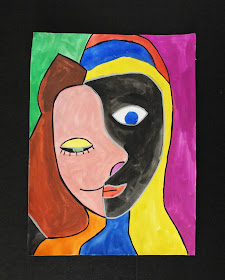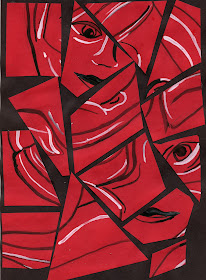 |
| METHOD 1 |
I have 2 methods to show you.
When describing the portrait I ask the students to see how he represents both the head on view and the side view together. I know that is a bit of a simplistic interpretation but all of a sudden I have kids really trying to interpret his paintings.....great to watch unfold.
MATERIALS REQUIRED:
- watercolor paper or heavy sketch/drawing paper
- pencil, eraser
- access to mirrors or use the partner method
- tempera disk paint
- sharpies or markers
- mounting paper
PROCEDURE:
To start get the students to draw an oval face with a neck and shoulders. Head on view.
Now if they have access to mirrors (class set of Dollar Store hand mirrors works well), have them draw a line down the center of the oval, (can be off kilter for a different look).
This will include the side view so they have to include some profile features like the nose in this line.
Now if you don't have access to mirrors a simple solution is to have the students working in pairs sketching their neighbor.
Now that the sketch is done it's time to paint. You can use realistic color choices or to add some drama unusual colors. (I usually go on here about how unusual colors signify dreams, visions, etc. in art)
Paint in all your sections. In my sample I've kept the colors of the side view different from the heads on view...it's up to you.
Finally to give our portrait some "pop" I take my trusty sharpies and use black and silver to outline my portrait.
Mount onto a contrasting color and you're done.
My friend and colleague, Kim McCllough, recently did this lesson with her Grade 5s. They used pastel instead of paint.
Terrific work everyone!
 |
| METHOD 2 |
MATERIALS REQUIRED:
- colored paper, or white drawing paper
- paper for mounting
- pencil and eraser
- paint, markers, pastels or pencil crayon
- scissors
- glue
PROCEDURE:
Take your colored paper or plain white and sketch out a self portrait. Use hand mirrors or the "sketch your neighbor" method.
You can do a head on or profile view.
Now add some color. Here I'm using colored paper so I'm only adding lines with black, grey and white. Incidentally I'm trying to keep to my value scale here. (good to do with older students)
Black lines are in shadow, white are highlights and grey middle value.
Now take those scissors and cut up your face. You want pieces around 2 inches (5 cm) or so. Try to keep some of the identifiable pieces intact, i.e. eyes, nose, mouth.
Take your mounting paper,arrange the cut up pieces and then glue into place. Remind the students that this is not a puzzle, the pieces should be out of synch.
That's it.
A interesting study you could do with your students is to do both methods and then display both side by side.
For additional Picasso study be sure to check out my previous post on an "Mask Study".
See you soon.












Love the 2 different versions..:)
ReplyDeleteHi, These are great projects. I quite like the cut up version. turned you simple illustration into a complex piece. I actually found your site looking for inspiration for my kids who are entering the So you want to be an artist contest that the National Gallery is holding. If any of your readers are working with older kids then they might be interested in this too. http://makeart.gallery.ca
ReplyDeleteI am so inspired on your site, everytime I visit. This Picasso project is wonderful, I have a 5 year old who loves art, but I think it might be a little advanced for her.
ReplyDeleteI just posted about your Picasso methods on Craft Gossip!
http://lessonplans.craftgossip.com/?p=5660
Really love how you've shown the process.
ReplyDeleteI absolutely love this lesson and am dying to try it out when I get back from maternity leave!
ReplyDelete